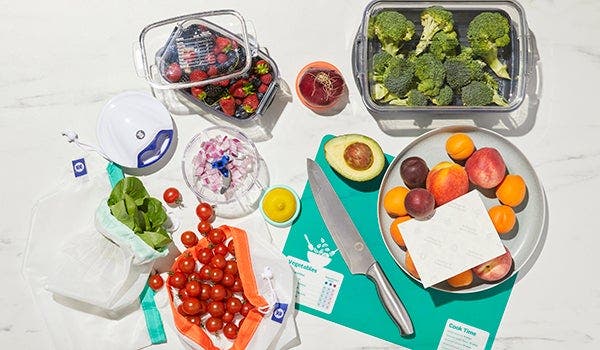These Are the Kitchen Tools You Actually Need


Whether you're setting up your first home, are looking to (finally) update that ’80s-era kitchen gear you nabbed from your mom’s basement, or are just starting to cook on the reg, having the right tools can make home-cooking a much happier—and easier—experience. But take one stroll down the aisle at your local big-box store and the amount of gadgets can feel totally overwhelming (do I really need a special tool just to de-stem strawberries?!).
So, we tapped the WW food experts to get the lowdown on the tools you truly need—and the ones that are just icing on the low-Points™ cake. Here, 16 expert-approved finds to simplify healthy food prep:
The Must-Haves
1. Stainless Steel Sheet Pans
Start with a few sheet pans in various sizes for maximum versatility, recommends WW food director Sherry Rujikarn. Using stainless steel isn’t just about the look—metal sheet pans (and other bakeware) with a darker finish can get hotter faster, she explains. While this might seem like a pro if you’re trying to speed through dinner prep, it could impact recipe cooking times on those one-pan dinners.
2. Nonstick Skillets
Do you need a set of a dozen skillets ranging from doll-size portions to party paella? You sure don’t. You really only need three sizes: 8, 10, and 12 inches. The larger 12-inch skillet is best for making family meals, but if you’re short on space, you’ll get very far with the two smaller sizes, Rujikarn says.
Now, to the nonstick versus stainless steel debate. Here’s the deal: You’ll get better browning with regular uncoated pans, but for ease of use (and cleanup), nonstick skillets are the better pick for everyday cooking. You also won’t have to use as much cooking oil, which can save Points. That said, if you’re an enthusiastic home chef looking for the perfect browned finish, Rujikarn says a 12-inch stainless steel skillet could be a good addition to your stash.
3. Chef’s Knife
While you can absolutely make do with inexpensive paring knives, a high-quality 8- to 10-inch chef’s knife is where you’ll want to spend a little more. The knife should be comfortable and slightly heavy, but not so heavy that you get tired from chopping veggies, Rujikarn says. Sharpen it at least once a year to keep it cutting smoothly and safely.
Looking to jump-start your collection? Knife sets are a good idea in theory, but like one of those mega eyeshadow palettes, chances are you won’t use half of them. To save space and money, focus on smaller sets, like this one from WW with three knives and built-in sharpeners.
4. Cutting Boards
Once you have a quality chef’s knife, it’s important to have a good surface to use it on. Rujikarn prefers wood (great for everything except raw chicken) or hard plastic that has a bit of nubby texture to it (this can also help keep your knives from getting too dull). The perfect size depends on your counter and sink space, but a good rule of thumb: Pick one that has at least one or two inches of extra space when you lay your chef’s knife on it diagonally. And if it doesn't have rubber feet on the underside, use this culinary school trick: Place a damp paper towel under the cutting board to keep it anchored in place as you slice.
5. Measuring Cups and Spoons
Measuring tools are a kitchen must-have if you plan on following any recipe. For staple ingredients, you’ll need a set of dry and liquid measuring cups, like WW’s angled measuring cup and stainless steel cups and spoons set. Why both? Because liquid measuring cups can’t be leveled, they aren’t accurate for dry ingredients, Rujikarn explains. And dry measuring cups don’t work for liquids because they can spill when you pick them up.
6. Food Storage Containers
If you’re thinking about starting a meal prep routine or always fumbling with leftovers, a good set of reusable storage containers is a must. When choosing the material, think about how you’ll use them most. If you’re planning to tote lunch to work every day, you may want to opt for mostly lighter plastic options (like this all-in-one container complete with utensils!) and save heavier glass for home, where you can take a premade salad straight from the fridge to the kitchen table.

The Nice-to-Haves
7. Tongs
We’ll let you in on a secret: Tongs are better than spatulas to flip things. (!) “If I’m cooking anything bigger than a dice, I use tongs,” Rujikarn says. Tongs are more adept at gripping, so you have more control—like an extension of your fingers, but burn-proof. Get a midsize set of silicone-tipped tongs to use with your nonstick skillets (they won’t scratch) and a regular stainless steel version to use when cooking with high heat.
8. Cast Iron Skillet
It’s one of the most classic kitchen additions for a reason: Cast iron skillets are an easy way to add more flavor to your dishes without doing much of anything. Like nonstick, you can use less salt and olive oil when cooking veggies and still get the same great taste, explains Angela Goscilo, MS, RD, CDN, nutrition manager at WW. She regularly reaches for her skillet to whip up fajitas, chicken, and more. And if you’re worried about it being high-maintenance, here’s a guide to caring for your cast iron.
9. Kitchen Shears
No, we aren’t suggesting you move your household scissors to the utensil drawer. Kitchen shears are designed to be much more heavy duty—in fact, they can handle tough tasks like breaking down a chicken with ease. Rujikarn recommends reaching for them any time you want a little extra control, like trimming green beans, snipping broccoli florets, or cutting dough.
10. Food Scale
A food scale is ultra helpful when you need precise measurements (baking is a science, after all) or if you want to get a better sense of portions and serving sizes. Newer digital versions are inexpensive, easy to use, and don’t take up much room. In fact, the WW by Taylor® Space-Saving Digital Food Scale is about the size and width of an iPad, so you can tuck it away almost anywhere when you’re not using it.
11. Food Processor
Want to outsource some dicing and chopping? A food processor is essentially your private line cook, making quick work of everything from chunky salsas to pasta-ready pesto, dips, chutneys, and all the salad fixings in between. Yes, you can hand-chop everything yourself, but with a few pulls of WW’s food processor you can have it done in seconds. It doesn’t require much counter space, and, because it’s manually operated, no outlet is needed.
12. Squeeze Bottles
It’s easy enough to whip up your own salad dressing before dinner in a bowl or glass, but if you want to make a bigger batch on meal-prep day and use it throughout the week, a set of reusable bottles can be a game changer, Rujikarn says. Get old-school squeeze bottles—think ones you might find at your local BBQ spot—or fancier versions with measure-markings and a handle, like the WW by Misto Salad Dressing Shaker Bottle. Rujikarn also likes using squeeze bottles to save citrus juice. Whether you have half a lemon leftover from making lemon chicken or a lime that’s about to go bad, squeeze them into bottles, and stash in the fridge.
The Extra Toppings
13. Silicone Bagel Pan
There’s nothing like a classic coffee-and-doughnut or coffee-and-bagel combo to start the day. But if you’re looking for a lower-Points alternative to your favorite baked good, consider making your own. WW’s bagel kit includes (almost) all the tools to whip up everything bagels and cinnamon-sugar doughnuts—all you need to supply is self-rising flour and Greek yogurt. Once you’ve mastered the basics, use the baking pan to experiment with new flavors. Try everything from apple cider or double-chocolate to savory mac & cheese or zucchini-pesto.
14. Specialty Produce Tools
You don’t need a dedicated tool for every type of fruit and veggie, but if you have the space and means, by all means, go for it for the produce you eat most. These tools can make it easier to get these foods out of the fridge and onto your plate—and let’s be honest, you’re more likely to reach for those healthful foods if they’re washed, prepped, and ready to go. Case in point: Avocado. If it’s a new addition to your ZeroPoint™ foods list, you might be cutting, pitting, and slicing the creamy fruit way more than usual. Get Insta-worthy slices quickly and safely with WW’s 3-in-1 Avocado Tool.
15. Popcorn Popper
Bags of popcorn are convenient, but some brands have extra salt, oil, and butter. To have more control over your add-ons (and Points), pop your own kernels in this silicone microwave popper (there’s even a mini version for personal portions!). Stick with your usual extras or take your popcorn to the next level with one of our flavor-packed seasonings.
16. Vegetable Spiralizer
Looking for new ways to add non-starchy veggies to your plate? Hello, zoodles. Zucchini noodles are a great swap for spaghetti and a delicious way to add some Points, but premade fresh or frozen versions can get pricey. Instead, make your own with a spiralizer. The best part: You can experiment with other veggies like yellow squash, carrots, beets, and more!
Related articles:
The Ultimate Guide to Creating a Safe Kitchen
How to Shop for Groceries Once and Eat for Two Weeks
